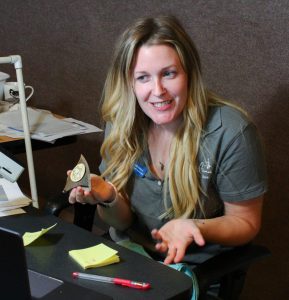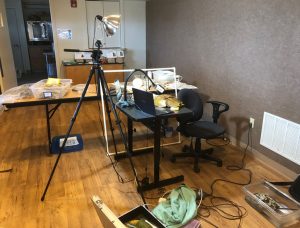by Erin Rawls, Outreach Coordinator
 For the Education Department, like so many others, this year is all about adaptation. Shifting our field trips into a virtual space has been no exception. Though this process has been demanding, the virtual programs so far have received great feedback. Virtual field trip programming is an exciting new way to be able to reach students, both near and far, that might be unable to visit The Wetlands Institute in person.
For the Education Department, like so many others, this year is all about adaptation. Shifting our field trips into a virtual space has been no exception. Though this process has been demanding, the virtual programs so far have received great feedback. Virtual field trip programming is an exciting new way to be able to reach students, both near and far, that might be unable to visit The Wetlands Institute in person.
So, how are we doing it? What happens behind the scenes of a virtual field trip?
Field trips are designed to be as interactive as possible, full of hands-on activities and exploration that bring science to life. Changing field trips in a way that meaningfully translates through a screen was a big hurdle, and one that took a great deal of creative thought to overcome. For example, after much consideration, a full field obstacle course style horseshoe crab game was turned into a virtual “choose your own adventure” activity. Instead of students encountering tangible obstacles as they physically maneuver the course, students would instead virtually choose a numbered horseshoe crab and follow along to see if it survived the many obstacles horseshoe crabs face during its life. During this activity, the pedagogy shifts in an impactful way that keeps students invested and interested, while still illustrating the core science concepts intended.
 Adapting field trip activities to the screen was the first challenge, but then there was the task of actually setting up to run the field trips. It is not as simple as sitting down with a laptop and logging in! Running a virtual program involves a lighting set up, external cameras, wireless microphones, sound buffers, technology troubleshoots, hosting platforms, and securing lots of visual materials to bring the concepts to life, including live animals, pictures of what a salt marsh looks like, and other audio and visual learning aids. While the setup and delivery methods are different, the principles of science remain the same. Come check it out at: wetlandsinstitute.org/education.
Adapting field trip activities to the screen was the first challenge, but then there was the task of actually setting up to run the field trips. It is not as simple as sitting down with a laptop and logging in! Running a virtual program involves a lighting set up, external cameras, wireless microphones, sound buffers, technology troubleshoots, hosting platforms, and securing lots of visual materials to bring the concepts to life, including live animals, pictures of what a salt marsh looks like, and other audio and visual learning aids. While the setup and delivery methods are different, the principles of science remain the same. Come check it out at: wetlandsinstitute.org/education.
